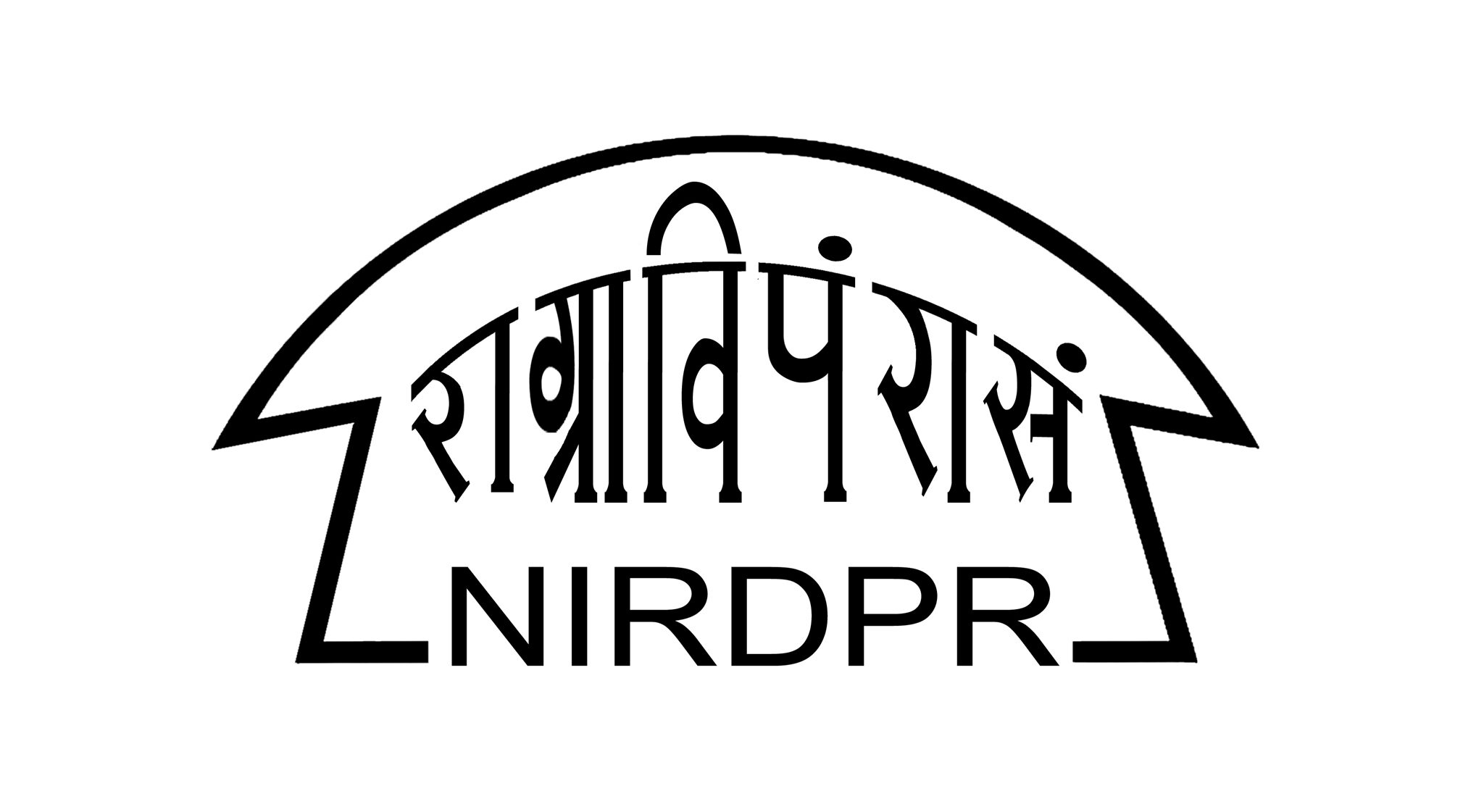
CONTENTS:
LEAD STORY: Maternal Malnutrition in Rural Women and Its Impact on the Neurological Development of Newborn
Hon’ble Union Minister of RD & PR Chairs Hindi Advisory Committee Meeting
NIRDPR Hosts National Stakeholder Consultative Workshop on Panchayati Raj System: Retrospect & Prospects
PM Interacts with NIRDPR Faculty during Sankalp Saptaah Launch
NIRDPR Conducts 17th Annual Convocation
Hon’ble Governor of Telangana Visits RTP, Interacts with Tribal Youth
Hindi Day and Third All India Official Language Conference, Pune
ARTICLE: Drones as a Catalyst in Enhancing Last Mile Deliveries: A Policy Perspective
Training Programme on Poverty and Inequality Estimation for ISS Probationers
Regional Workshop on Capacity Building of School Management Committees in Rural Areas
Training Programme on Development of Managerial Skills for Fishery Officers from Odisha
TOLIC-2 Meeting at Council for Social Development under the Aegis of NIRDPR
ARTICLE: Understanding the Association for Computing Machinery (ACM): A Pillar of the Computer Science Community
ToT on GIS-based Planning and Monitoring of MGNREGA at IGPR&GVS, Rajasthan
ToT on Capacity Building programme on e-GramSwaraj Portal for PRI Functionaries at GIPARD
LEAD STORY:
Maternal Malnutrition in Rural Women and Its Impact on the Neurological Development of Newborn
Dr. Pranab Kumar Ghosh
Assistant Registrar (T) & ( E ), National Institute of Rural Development & Panchayati Raj, Hyderabad
pkghosh.nird@gov.in
&
Ms. Chandrika Tamarana
Consultant Nutritionist & Assistant Professor, Dr. Bharathi Rao Rehabilitation Centre, Hyderabad
& Member of Nutrition Society of India
In India, rural women play a key role in supporting their households as primary caretakers of families and communities in achieving food and nutrition security, generating income and improving rural livelihoods and overall well-being. They contribute to agriculture and rural enterprises, fuel the local economy and are considered as an important pillar of society. However, due to several factors, women were not given much importance to their health and overall well-being in a family when compared to men and were prone to diseased conditions such as being underweight due to inadequate food intake and food availability.
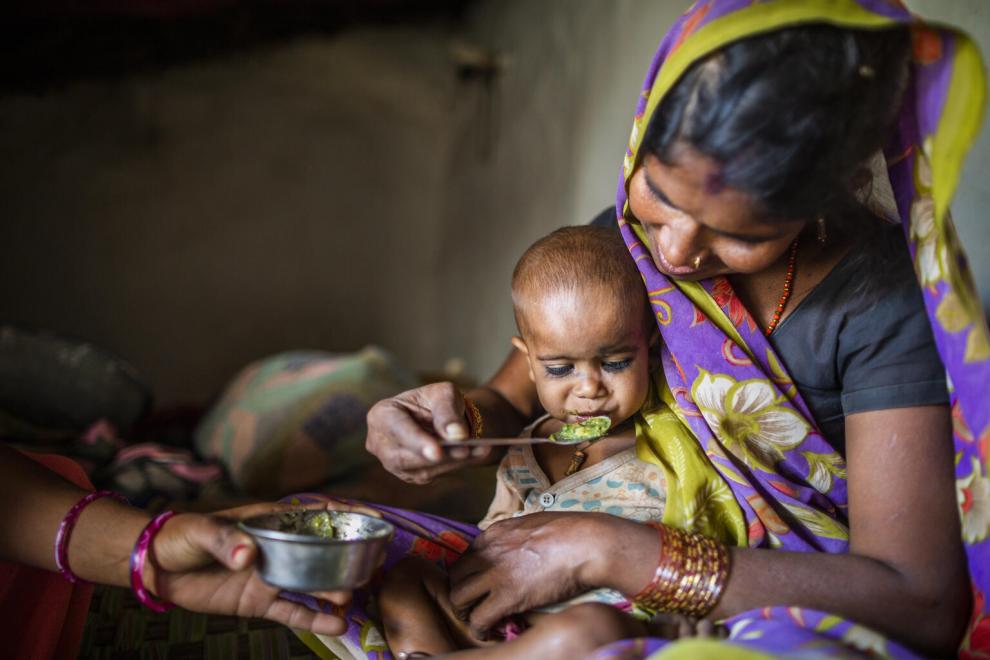
Early marriage also has a significant impact on the lives of young girls. It often leads to early pregnancy and childbirth, which can have serious health consequences for both the mother and child such as malnutrition, wasting, stunting in mothers and neural tube defects, developmental delay in children. Girls in this age group are twice as likely to die during pregnancy or childbirth as women in their twenties. Therefore, maternal malnutrition in rural women is a pressing global health challenge with far-reaching consequences for both the mother and child due to limited access to proper healthcare, education and nutritious food, exacerbating the problem and leading to adverse maternal and child health outcomes.
Maternal Malnutrition
Malnutrition, as defined by WHO (World Health Organisation) refers to nutrient deficiencies, excesses or imbalances in an individual intake of energy and/or nutrients. The term malnutrition covers two broad groups of conditions. One is ‘undernutrition’—which includes stunting (low height for age), wasting (low weight for height), underweight (low weight for age) and micronutrient deficiencies or insufficiencies (a lack of important vitamins and minerals). The other condition is overweight (excessive consumption of calories), obesity and diet-related non-communicable diseases (such as heart disease, stroke, diabetes, and cancer).
India, a country with a rich cultural heritage and diverse food habits, is grappling with a significant challenge – malnutrition among women. This issue is not just confined to a particular age group but spans across the entire life cycle of women, leading to a vicious intergenerational cycle of undernutrition. A quarter of women of reproductive age in India are undernourished, with a body mass index (BMI) of less than 18.5 kg/m. This statistic is alarming as it highlights the scale of the problem. The diets of women in India are often too poor to meet their nutritional needs. This undernourishment is more prevalent in rural areas due to factors such as poverty, lack of education, and limited access to quality healthcare. Undernourished mothers are more likely to give birth to undernourished children, perpetuating an intergenerational cycle of malnutrition.
Recent Scientific evidence suggests that in India, more than half of women are anaemic, nearly 40 per cent in the age group of 15-49 years are underweight, and nearly 25 per cent are overweight/obese. Inadequate dietary intake of quantity and quality is an established determinant of poor maternal nutrition. A survey by the National Nutrition Monitoring Bureau (NNMB) in 10 Indian States indicates that cereals and millets form the bulk of rural diets, with only about half of pregnant women consuming adequate quantities of protein and energy. NNMB also showed that intakes of iron, vitamins A and C, and folic acid were less than 50 per cent of recommended levels for most pregnant women. Some of the causes such as sub-optimal diets, including early and multiple pregnancies, poverty, caste discrimination, and gender inequality and also other factors contribute to poor maternal nutrition in India.
Unbalanced dietary patterns before conception may be related to long-term maternal metabolic conditions such as metabolic syndrome, obesity and diabetes. Those conditions have also been identified as environmental risk factors for Autism Spectrum Disorders as well as other neurodevelopmental disorders. Undernutrition in mothers can lead to low birth weight (LBW- <2.5 kg) and preterm deliveries (<37 weeks of gestation). These adverse pregnancy outcomes can have long-term health implications for both the mother and the child.
Impact of Maternal Malnutrition in Rural Women
An undernourished mother inevitably gives birth to an undernourished child, perpetuating an intergenerational cycle of undernutrition. Undernourished girls have a greater likelihood of becoming undernourished mothers, who in turn, have a greater chance of giving birth to low birth weight babies. This cycle can be compounded further in young mothers, especially adolescent girls who begin childbearing before they have grown and developed enough.
Malnutrition mainly the undernutrition such as wasting, stunting and micronutrient deficiencies observed in pregnant women can have significant consequences for the neurological development of newborns. Neurological disorders in children are a significant public health concern in rural India. These disorders encompass a wide range of conditions from developmental delays and learning disabilities to more severe conditions like epilepsy, cerebral palsy and autism spectrum disorders. Unfortunately, children in rural areas of India often face unique challenges in accessing timely diagnosis treatment support for their neurological conditions.
Adequate nutrition is the foundation of any individual’s health and is especially critical for women because inadequate nutrition can harm their health as well as the child. Children of malnourished women are more likely to face cognitive impairments, short stature, weak immune system, and a higher risk of illness and death throughout their lives (see Figure 1 below).
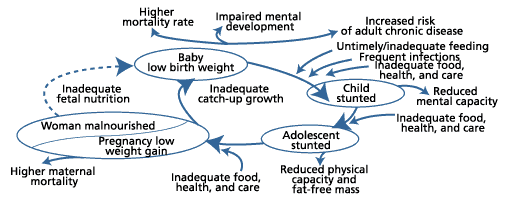
Source: Adapted from the ACC/SCN-appointed Commission on the Nutrition Challenges of the 21st Century.
Women having a short gestation period and many children can cause maternal nutrition that can be passed on to their children. Foetal stunting is largely caused by the mother’s inadequate nutrition before conception and in the first trimester. Efforts are being made to break this cycle. For instance, UNICEF India’s current nutrition programme focuses especially on women’s nutrition before, during and after pregnancy. Their goal is to universalise the coverage of essential nutrition interventions for women.
Strategies to Combat Maternal Malnutrition in Rural Women, Nourishing a Healthier Generation
- One of the main strategies to improve maternal nutrition in rural India includes programmes and policies that address nutrition by providing take-home rations for pregnant and lactating women. Its purpose is to provide nutrient-rich food to women who might otherwise struggle to access or afford adequate meals.
- Implementing community nutrition education programs is an important step in combating maternal malnutrition. Educating women and their families about the importance of healthy eating during pregnancy and the impact of malnutrition on maternal and child health can increase awareness of food choices and healthy eating habits.
- Encourage the consumption of nutrient-rich foods in rural households. Local agricultural practices can be promoted to grow a variety of fruits, vegetables, and grains. Additionally, initiatives like backyard kitchen gardens can empower women to grow their own nutritious foods, ensuring a regular supply of fresh and healthy produce.
- Providing prenatal supplements containing essential vitamins and minerals, such as iron, folic acid, and calcium, can significantly reduce the risk of nutritional deficiencies during pregnancy. These supplements should be made readily available and accessible to rural women, particularly those with limited access to diverse diets.
- Investing in healthcare infrastructure in rural areas is crucial to combat maternal malnutrition. Establishing well-equipped health centres and mobile health units can ensure timely access to maternal care, nutritional counselling, and prenatal services.
- Empowering rural women through education, vocational training, and income-generating opportunities can positively impact maternal nutrition. By improving their socio-economic status and decision-making power, women are more likely to prioritise their health and the well-being of their children.
- Advocating for government policies that prioritise maternal nutrition and offer incentives to support women’s access to nutritious food during pregnancy can have a significant impact. These policies should be designed to address the unique needs of rural women and foster positive change at the grassroots level.
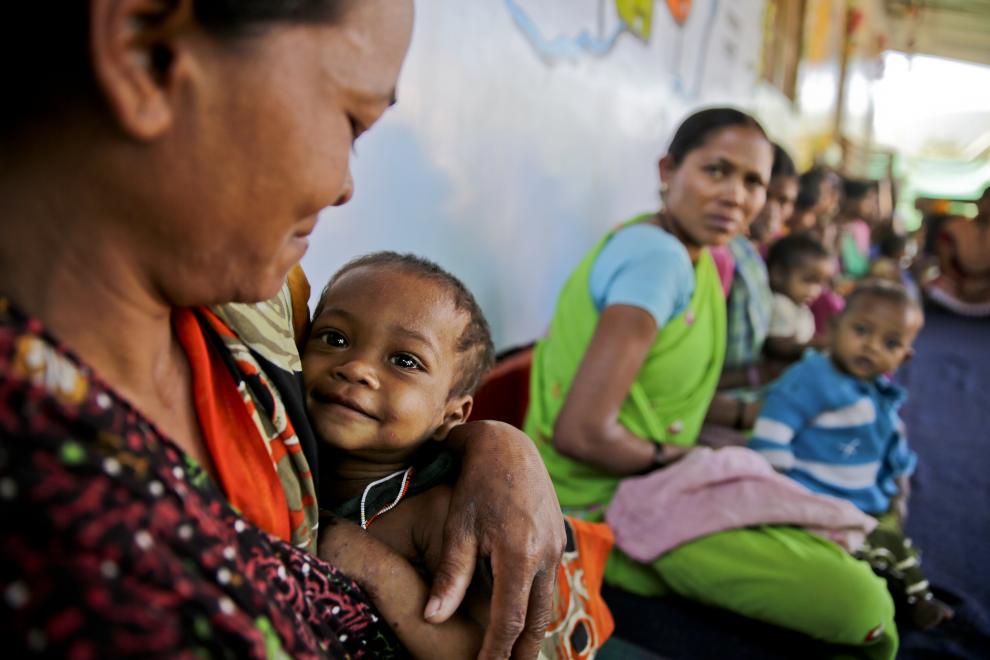
Way Forward
Combating maternal malnutrition among rural women requires a multifaceted approach that integrates nutrition education, prenatal care, healthcare infrastructure development, and women’s empowerment.
By addressing the root causes of malnutrition and promoting healthy dietary practices, we can nourish a healthier generation in rural communities.
By empowering rural women with knowledge and resources, and working collaboratively with governments, NGOs, and community-based organisations, we can pave the way for better maternal and child health outcomes, contributing to the overall well-being and sustainable development of rural areas.
Improving women’s nutrition can also help the nation achieve the Sustainable Development Goals, which are commonly accepted as a framework for measuring development progress.
(Inputs have been taken from WHO Articles, National Institute of Health (NIH), UNICEF and National Nutrition Monitoring Bureau (NNMB)).
Hon’ble Union Minister of RD & PR Chairs Hindi Advisory Committee Meeting
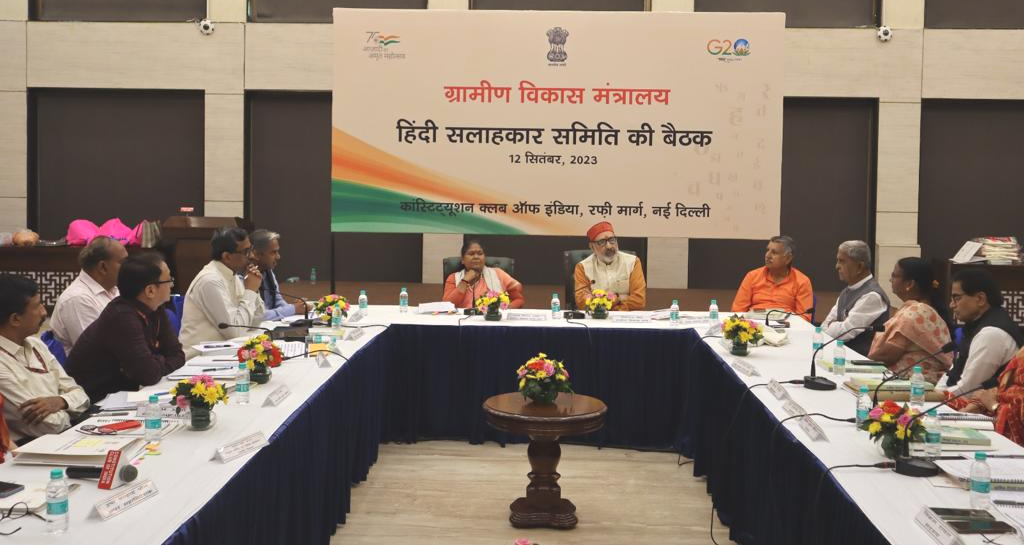
The meeting of Hindi Advisory Committee was held on September 12, 2023, in New Delhi, under the chairmanship of Shri Giriraj Singh, Hon’ble Union Minister of Rural Development and Panchayati Raj. Ms Sadhvi Niranjan Jyoti, Hon’ble Minister of State for Rural Development, Consumer Affairs, Food and Public Distribution also attended the meeting, besides Director General, NIRDPR, Secretary, Joint Secretary and other officers of the Ministry of Rural Development.
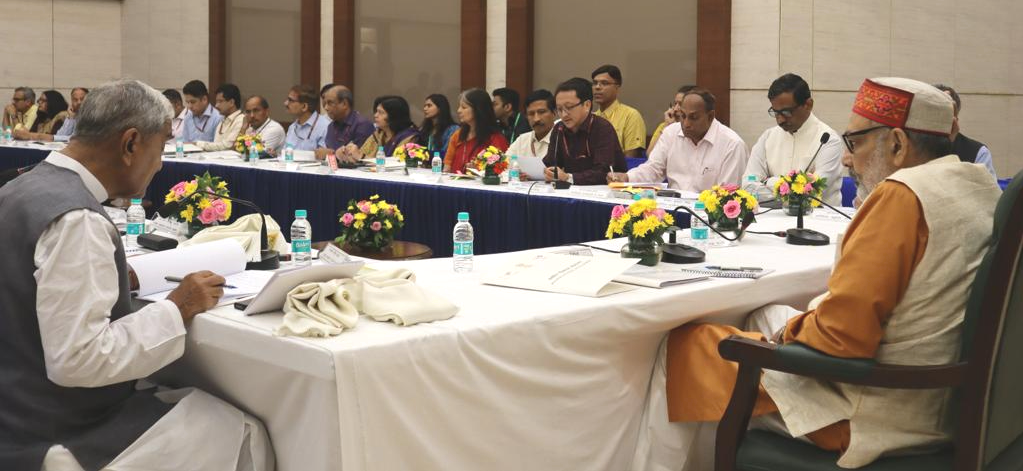
At the outset, the Secretary, MoRD welcomed all participants and briefed them about the Hindi work done, and notable achievements of the Ministry during the year. The members of the committee reviewed and appreciated the Hindi work of the Ministry, including subordinate offices.
NIRDPR Hosts National Stakeholder Consultative Workshop on Panchayati Raj System: Retrospect & Prospects
The National Institute of Rural Development and Panchayati Raj (NIRDPR), Hyderabad, hosted a two-day National Stakeholder Consultative Workshop on ‘Panchayati Raj System: Retrospect & Prospects’ organised under the aegis of the Ministry of Panchayati Raj, Government of India in collaboration with the Institute on 4th September 2023. The event was planned to deliberate on emerging and pressing issues of Panchayats and the roadmap/way ahead for enabling Panchayats as “Change Makers” or “Agents of Change”.

Shri Sunil Kumar, Secretary, Ministry of Panchayati Raj, inaugurated and presided over the inaugural session of the workshop in the presence of Dr G. Narendra Kumar, Director General, NIRDPR, Dr Chandra Shekhar Kumar, Additional Secretary, Ministry of Panchayati Raj, Shri Vikas Anand, Joint Secretary, Ministry of Panchayati Raj and Smt. Mamta Varma, Joint Secretary, Ministry of Panchayati Raj. The renowned stalwarts of Panchayati Raj system of India of olden times also graced the National Workshop with their august presence, and prominent among them were Dr S. S. Meenakshisundaram, former Secretary, Ministry of Rural Development, Government of India; Dr Manabendra Nath Roy, former Additional Chief Secretary to Government of West Bengal; and Dr S. M. Vijayanand, former Secretary, Ministry of Panchayati Raj.
Addressing the gathering, Shri Sunil Kumar, Secretary, Ministry of Panchayati Raj advised the participants to take personal interest in promoting the cause of Panchayats so that the Panchayati Raj system all over the country is equivalent to or even better than that of the pioneering States. The immediate areas where Panchayats should focus are those related to Panchayat Development Plans, Panchayat Development Index, Localisation and Achievement of Sustainable Development Goals. He called upon Panchayats to be the catalysts of change to accelerate the pace of progress towards the achievement of the global goals in nine thematic areas identified for Panchayati Raj Institutions.
Shri Sunil Kumar said that the Ministry of Panchayati Raj is taking a leadership role in the process of Localisation of Sustainable Development Goals (LSDGs) involving Central Ministries/Departments, State Governments, NITI Aayog and Panchayati Raj Institutions (PRIs) by evolving nine thematic approaches to attain SDGs in rural areas. Panchayat Development Index (PDI) is a multi-dimensional assessment index which measures the progress of Panchayats towards the attainment of LSDGs, he added.
Shri Sunil Kumar noted that as our nation is committed to achieving SDGs by 2030, the Baseline Report of the Panchayat Development Index (PDI) would definitely serve as a benchmark for the Ministry/Department in monitoring and evaluation of the progress made in achieving the targets concerned of the SDGs aligned to different flagship schemes/programmes and through localised SDGs.
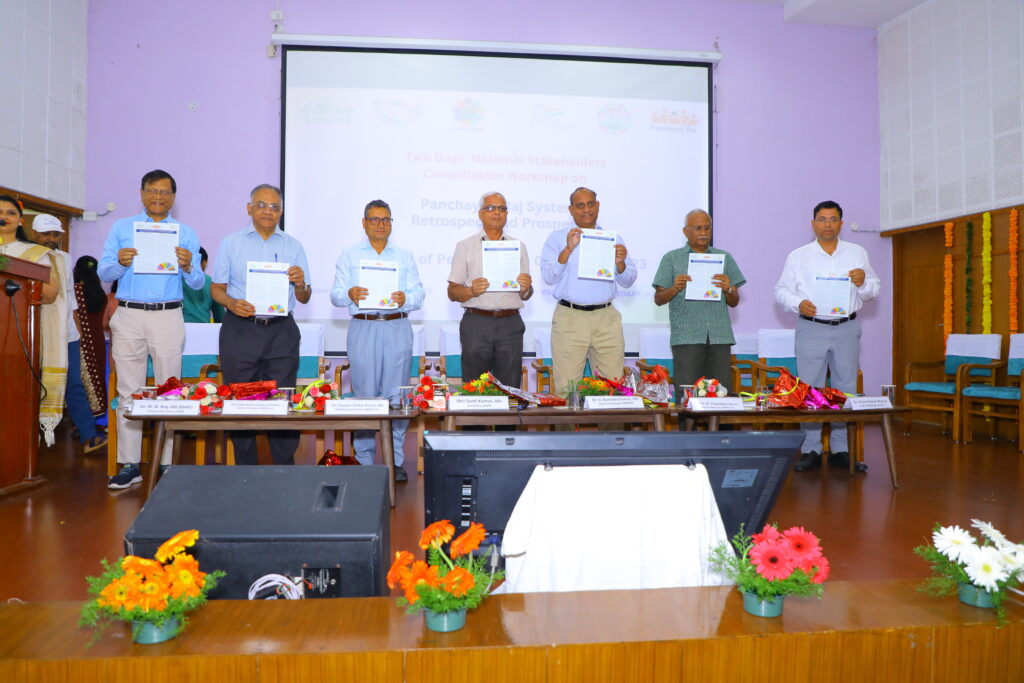
On the occasion, the People’s Plan Campaign (PPC) 2023 for the preparation of the Panchayat Development Plans (2024-2025) was launched. A Report on Formulation of Project Driven Block Panchayat and District Panchayat Development Plan prepared by the Committee constituted by the Ministry of Panchayati Raj and National Training Module of Panchayat Development Index and a special issue of NIRDPR’s Journal of Rural Development in the context of completion of 30 Years of the 73rd Constitutional Amendment, and the brochure on the School of Excellence in Panchayati Raj (SoEPR) at NIRDPR to mark the initiation of foundation of SoEPR were also released.
Addressing the participants through a presentation on setting up the School of Excellence in Panchayati Raj (SoEPR), Dr G. Narendra Kumar, Director General, NIRDPR said that the establishment of the SoEPR at NIRDPR would help in strengthening the Panchayati Raj system and cater to their needs of knowledge on Panchayats and capacity to deliver the services to citizens more effectively. He added that with support from the MoPR, NIRDPR has established a School of Excellence in Panchayati Raj (SoEPR) with nine new Centres in addition to the existing 21 Centres to delve into different domains of the Panchayati Raj system and to create a strong knowledge base for dissemination and application through the Panchayats across India.
Setting the context for the National Workshop, Dr Chandra Shekhar Kumar, Additional Secretary, Ministry of Panchayati Raj shared that now the aspirations and expectations of the rural people have been increasing and Panchayats are considered as drivers of rural transformation and added that undoubtedly, Panchayats need to be equipped to emerge as drivers of rural transformation. He underscored that it is imperative to envision capacity building with a fresh ‘eco-system’ approach in core areas of Panchayats and emerging needs arising with the changing governance mechanism to attain holistic, inclusive and sustainable development of villages.
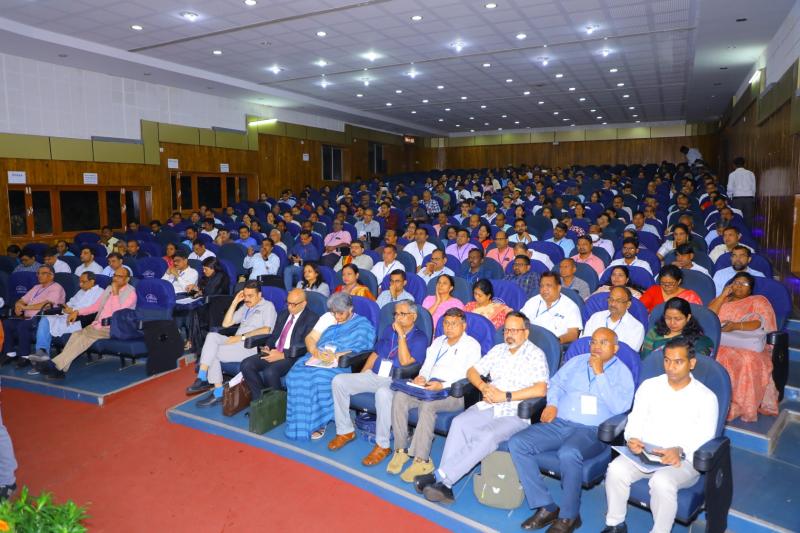
Shri Vikas Anand, Joint Secretary, Ministry of Panchayati Raj made a detailed Presentation on People’s Plan Campaign–2023 and Road Ahead stating that the Mantra of People’s Plan Campaign is Sabki Yojana Sabka Vikas and the initiative of Panchayat Development Plan (PDP) envisages formulation of well-thought-out Gram Panchayat Development Plan (GPDP) as well as Project-Driven Block Panchayat Development Plan (BPDP) and District Panchayat Development Plan (DPDP) which will pave the way for qualitative transformation and sustainable development in rural areas across the country.
Dr. Anjan Kumar Bhanja, Associate Professor, NIRDPR delivered the welcome address. After the inaugural session, the delegates proceeded to round table discussions on the objectives and deliverables of each of the Thematic Groups. The participants were formed into six Groups and 21 Sub-Groups to brainstorm on the 21 issues pertaining to the effective functioning of the Panchayati Raj system.
Secretaries, Joint Secretaries and Directors of Panchayati Raj Departments, Presidents and CEOs of District Panchayats, Presidents and Secretaries of Block Panchayats, Sarpanches of Gram Panchayats and Officials of State Institutes of Rural Development & Panchayati Raj from the States and Union Territories across the country participated in the workshop. Representatives of State/UT Departments of Panchayati Raj, faculty–members of NIRDPR, SIRD&PRs, Indian Institute of Public Administration (IIPA), Panchayati Raj Training Institutes, UN agencies, CBOs, NGOs, elected representatives & functionaries of Panchayats from across the country, key stakeholders, domain experts and agencies doing commendable work in Panchayati Raj sector at grassroots level were also among the participants.

Shri Ramit Maurya, Director, Ministry of Panchayati Raj and three Officer Trainees of IAS 2021 Batch attached as Assistant Secretaries in the Ministry of Panchayati Raj Shri Om Prakash Gupta, Ms Pallavi Verma and Shri Subhankar Bala also attended the workshop.
The six main topics of the brainstorming workshop were (i) Panchayat Election, (ii) Gram Sabha & Standing Committees and their Empowerment, (iii) Functioning of Panchayats, (iv) Panchayat Finances and Own Source of Revenue, (v) Leadership Role for Elected Women Representatives (EWRs), and (vi) Evidence–based Planning.
Appreciating the initiative of Ministry of Panchayati Raj and NIRDPR, the participants opined that the National Workshop would show the right path for deepening democracy in Gram Panchayat areas.
PM Interacts with NIRDPR Faculty during Sankalp Saptaah Launch
Hon’ble Prime Minister of India Shri Narendra Modi interacted with NIRDPR faculty during the launch of Sankalp Saptaah at Bharat Mandapam, ITPO, New Delhi, on 30th September 2023. This week-long initiative from 3rd – 9th October aimed at improving the development drive and governance in Aspirational Blocks across the country for the effective implementation of Aspirational Block Programme.
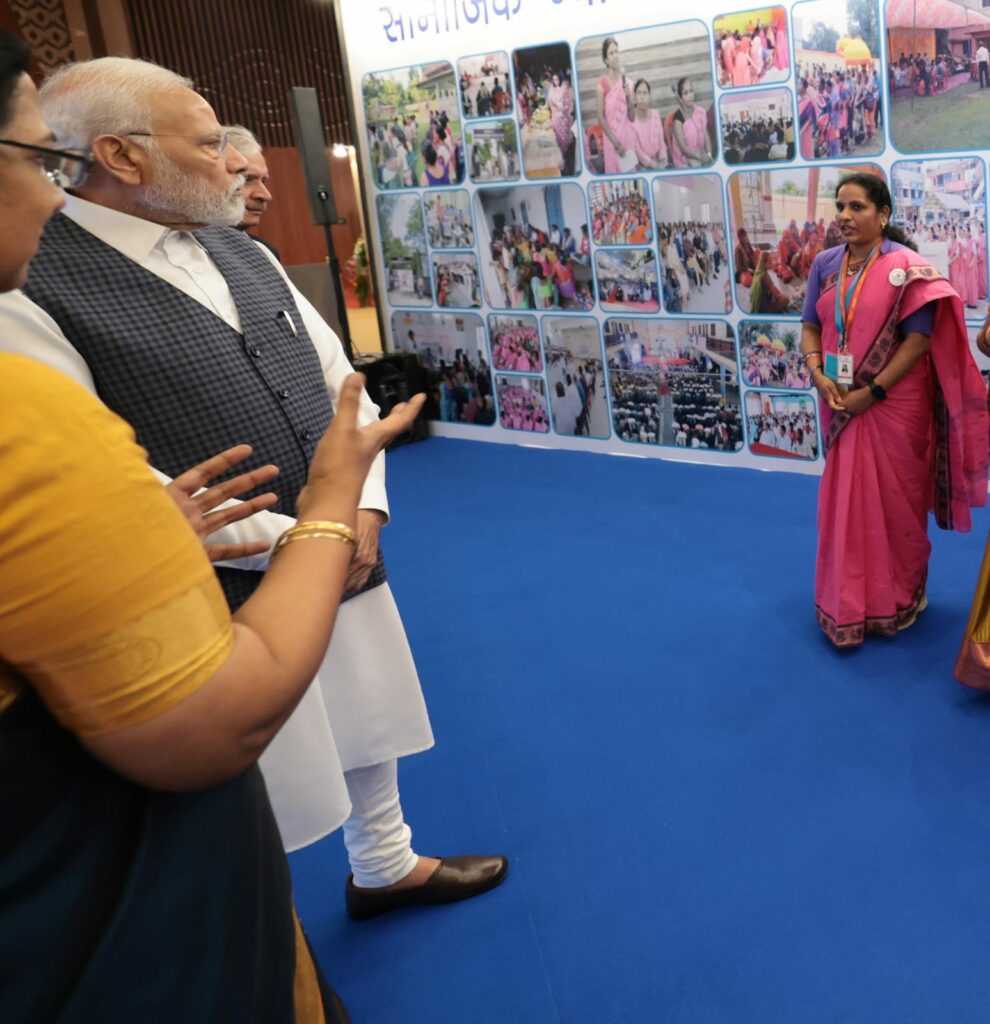
Dr G. Narendra Kumar, IAS, Director General, NIRDPR and Dr Anuradha Palla, Assistant Professor, Centre for Wage Employment & Livelihoods, represented the Institute at the event.
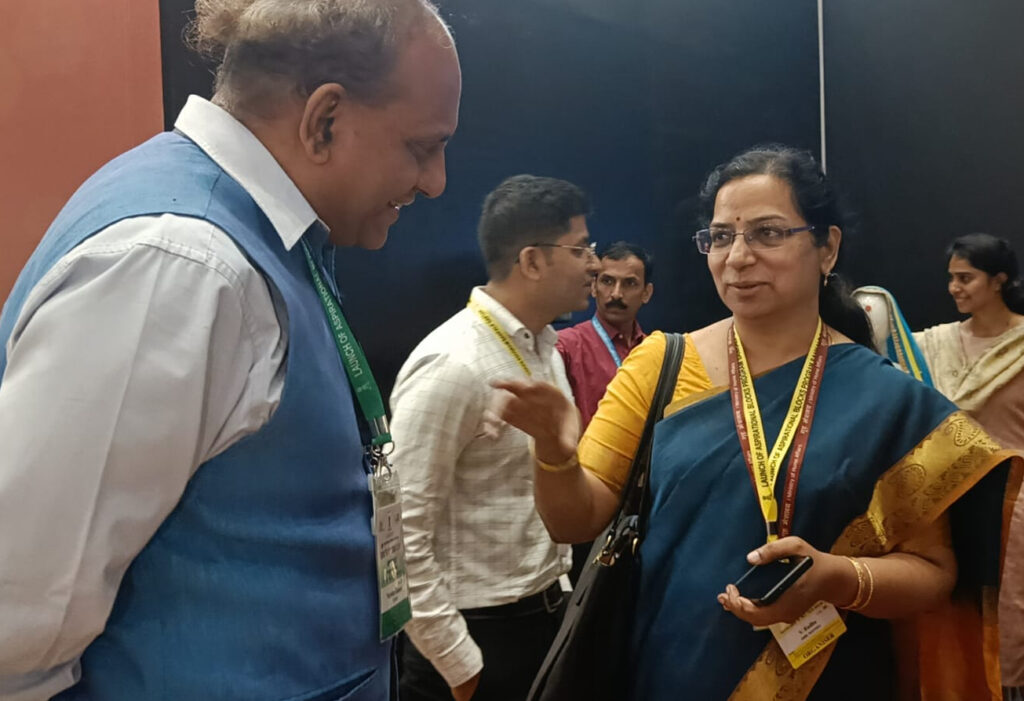
While meeting the Block Pradhans, Gram Panchayat Sarpanchs and other field functionaries, the Prime Minister interacted with Dr. Anuradha Palla, who is a Master Trainer of the Aspirational Block Programme – Leadership Module. During the interaction, the PM enquired about the conduct of training and the process of Chintan Shivir for formulating Block development strategy.
NIRDPR Conducts 17th Annual Convocation
The 17th Annual Convocation of the National Institute of Rural Development & Panchayati Raj was conducted on 29th September 2023 on its Hyderabad campus.
Sadhvi Niranjan Jyoti, Hon’ble Minister of State for Rural Development, Consumer Affairs, Food and Public Distribution GoI, graced the occasion as the Special Guest. The Convocation Address was delivered by Prof. Mamidala Jagadesh Kumar, Hon’ble Chairman of UGC, and the Chief Guest on the Occasion. Dr G. Narendra Kumar, IAS, Director General NIRDPR and Chairperson of the Academic Committee presided over the function.
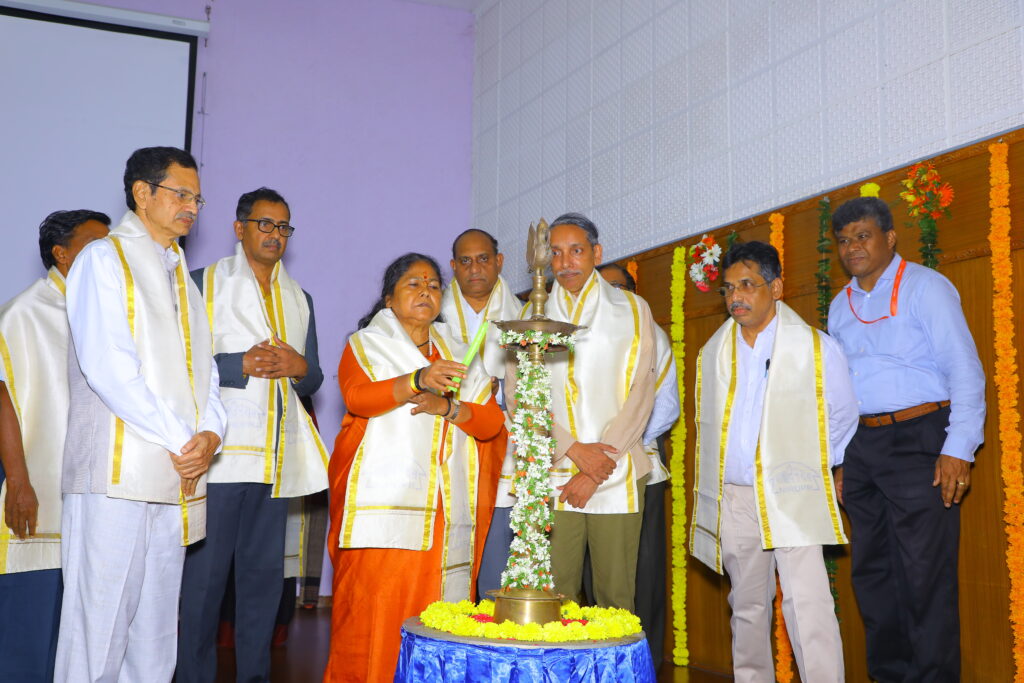
After the lighting of the lamp, the Director General of NIRDPR & Chairperson of the Academic Committee declared the convocation as open.
Dr A. Debapriya Associate Professor, NIRDPR welcomed all the dignitaries, invitees, faculty and graduates and presented a broad sketch of the course reports of Post Graduate Diploma in Rural Development Management and Post Graduate Diploma in Management – Rural Management offered by the Institute.
A total of 191 students graduated from the two academic programmes of NIRDPR, including 81 from Post Graduate Diploma in Management – Rural Management and 114 from Post Graduate Diploma in Rural Development Management
Four students received Gold, Silver and Bronze Medals each from the PGDRDM and PGDRM- RM Course, respectively. Three International Students, representing Indonesia, Myanmar and Bangladesh, also received student bronze medals for the one-year Post Graduate Diploma in Rural Development Management Course.
Speaking on the occasion, Sadhvi Niranjan Jyoti, Hon’ble Minister of State for Rural Development, explained the need for sending the trained students to the different Panchayats for training and empowerment of elected representatives. She said that the focus should be on creating awareness on issues of women’s rights and constitutional privileges in rural India and making the Panchayats more self-reliant. The Minister urged the students to work with selfless compassion and devotion to uplift rural India.

Delivering the Chief Guest address, Prof. Mamidala Jagadesh Kumar congratulated the faculty, staff and students and expressed his gratitude for having the opportunity to be present at the 17th Convocation of the Institute. He congratulated the new graduates, who by their hard work and perseverance had achieved culmination in their academic pursuit, and asked them to make the best use of their knowledge to attain professional success. He said sustainable rural development is the key to making India a developed country, and the focus hence should be on strategies and interventions which are in tune with the changing socio-economic and environmental factors.
Dr G. Narendra Kumar, IAS, Director General NIRDPR administered the Convocation Oath. Congratulating the graduates on this momentous occasion, he urged the students to apply their knowledge and learnings for the betterment of rural society and to demonstrate the skills to contribute towards building a strong, resilient and inclusive society.
Dr Jyothis Sathyapalan, Professor and Head Centre for Post Graduate Studies & Distance Education, NIRDPR, in his address, said that the students graduating from the Institute are working in different sectors of rural development and contribute to the nation-building by helping the process of rural transformation, i.e. high growth, poverty eradication, sharing the prosperity and sustainability in an inclusive manner.
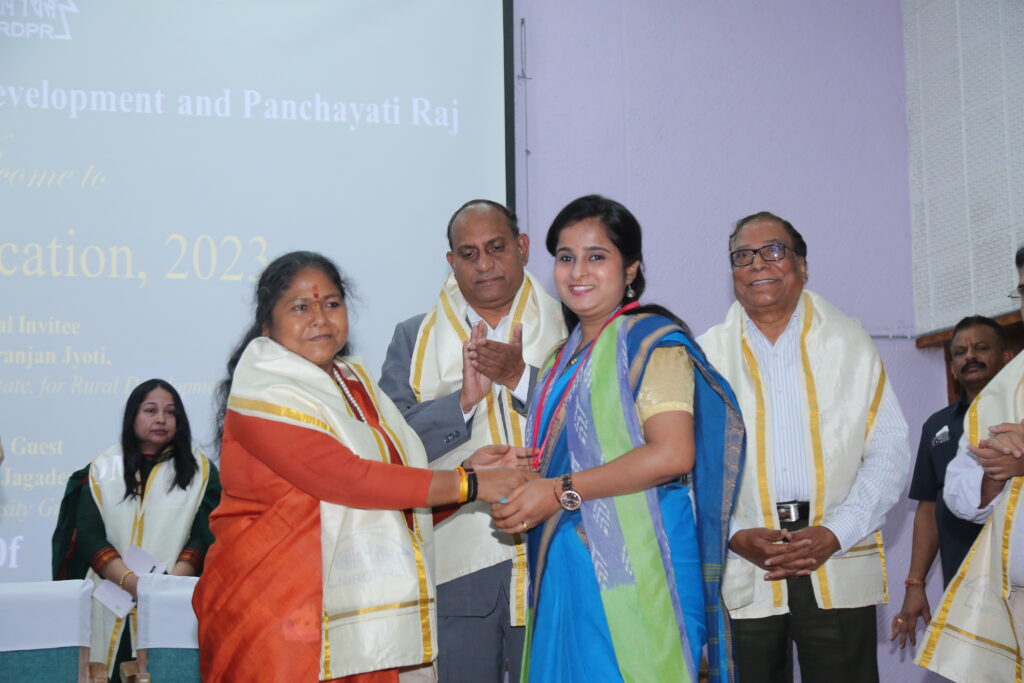
Prof Mamidala Jagadesh awarded the Diploma Certificates and the Medals to the Students. Faculty Members of NIRDPR and other dignitaries were also present on the occasion.
Dr Akanksha Shukla, Associate Professor, NIRDPR and the Academic Coordinator of the PGDRDM & PGDM-RM Courses, delivered the vote of thanks.
Hon’ble Governor of Telangana Visits RTP, Interacts with Tribal Youth
Hon’ble Governor of Telangana Dr. (Smt.) Tamilisai Soundararajan visited the Rural Technology Park (RTP) on the NIRDPR Campus at Rajendranagar on 8th September 2023 and interacted with the 26 tribal youth who were undergoing training on Leaf Plates and Cups Making Technologies.
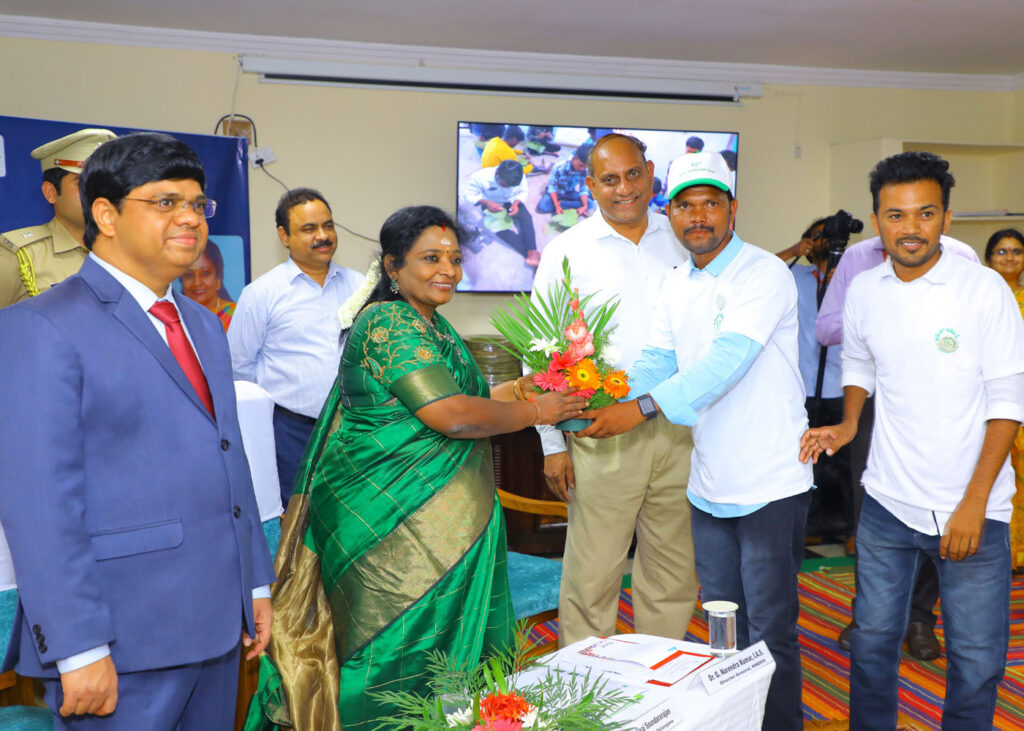
The trainees were from the tribal villages of Gogulapudi, Chinnallaballi, Mangli, Ankapur, Anrapur and Sarapaka in Adilabad and Bhadradri Kothagudam districts, adopted by the Hon’ble Governor of Telangana. During her interaction with the participants, the Governor assured them that one Leaf Plate Making Machine for each village would be provided from her side to start the activity by 2nd October 2023. She further thanked NIRDPR for the proactive role played in providing the training to the tribal youth. Shri Surendra Mohan, IAS, Secretary to the Governor also spoke about the initiatives taken by Raj Bhavan and NIRDPR in supporting the tribal youth of these adopted villages.
Dr G. Narendra Kumar, IAS, Director General, NIRDPR said that a comprehensive livelihood promotion programme would be devised to provide self-employment-oriented training in saturation mode for all the 211 families residing in these six adopted villages. The representatives of Red Cross Society and TRIFED (tribal Cooperative Marketing Federation) offered support for the marketing of their products.
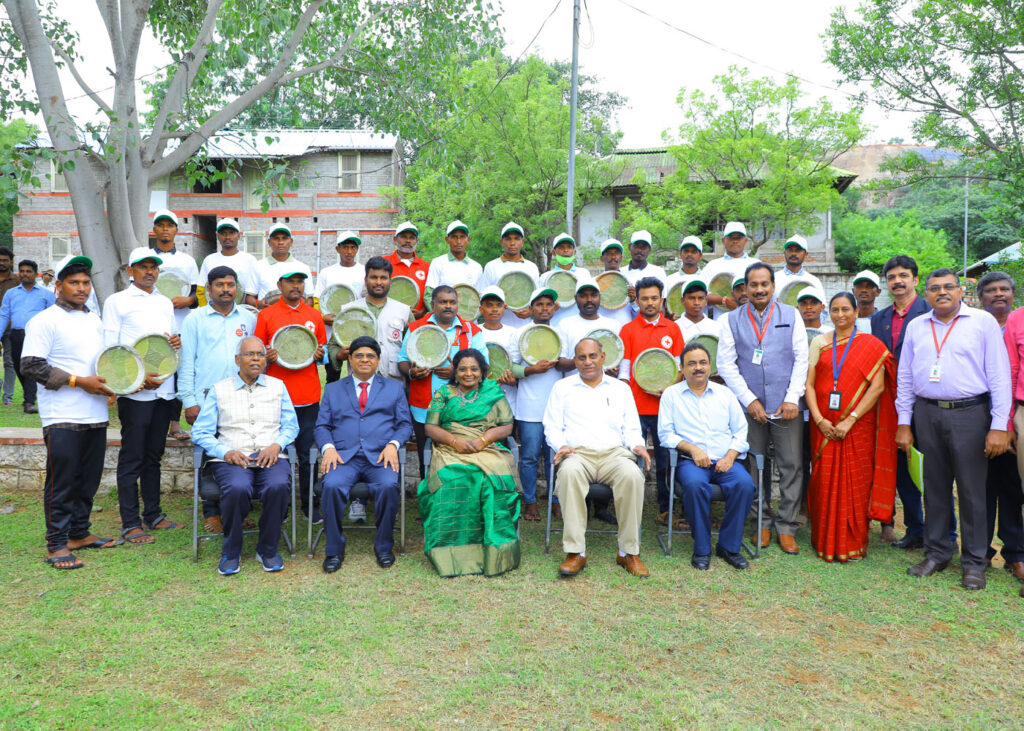
Dr C. Kathiresan, Associate Professor, Mr Md Khan, Senior Consultant and Dr Ramesh Sakthivel, Associate Professor, Shri Raghu Prasad, Joint Secretary, Raj Bhavan and Mr RD Raj, Technology Partner-RTP also were present.
Hindi Day and Third All India Official Language Conference, Pune
The Ministry of Home Affairs, Government of India, conducted the Hindi Day and 3rd All India Official Language Conference at the Shiv Chhatrapati Shivaji Sports Complex in Pune on 14-15 September 2023 with the aim of strengthening linguistic unity and promoting the Hindi language. The inauguration was done by Hon’ble Union Minister of State for Home Shri Ajay Mishra in Pune on 14th September.
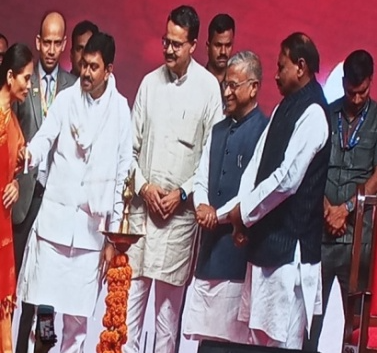
In the various sessions of Hindi Diwas and Official Language Conference, the status of progressive use of the official language Hindi and its improvement was discussed in detail.
Hon’ble Deputy Chairman Rajya Sabha, Shri Harivansh, Hon’ble Minister of State for Home Shri Ajay Mishra, Hon’ble Minister of State for MSME Shri Bhanu Pratap Verma, Hon’ble Minister of State for Health Dr Bharti Pawar, Hon’ble Deputy Chairman Parliamentary Official Language Committee Shri Bhartrihari Gahtab attended this mega event.
During the conference, an e-dictionary of 3.51 lakh Hindi words titled “Hindi Shabdesindhu” and an e-office app ‘Contasthash’ were launched. Secretary of the Official Language Department of the Home Ministry, Ms. Anshuli Arya said that currently, information is available in Hindi and other languages on the websites of various ministries. He said that the websites are being developed in such a way that the first option for information is available in Hindi language.
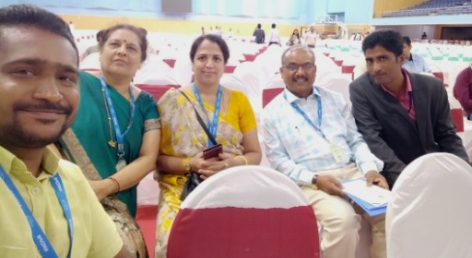
The topics discussed in this conference included Official Language @ 2047: Linguistic Panorama of Developed India (including Artificial Intelligence), Role of Media in the Development of Hindi and Indian Cinema and Hindi. More than 10,000 Hindi adhikari/karmachari/bhashavid from across the country participated in this two-day event.
Earlier, the Rajbhasha Vibhag had sent letters to Ministries/Departments/Affiliated and Subordinate Offices/Banks/Undertakings/Corporations/Boards, etc., regarding celebration of the Hindi Pakhwada from 14th to 29th of September and organising various competitions during the same period. The outline of the programme was made in such a way that the Hindi Diwas of every office started on 14th September 2023.
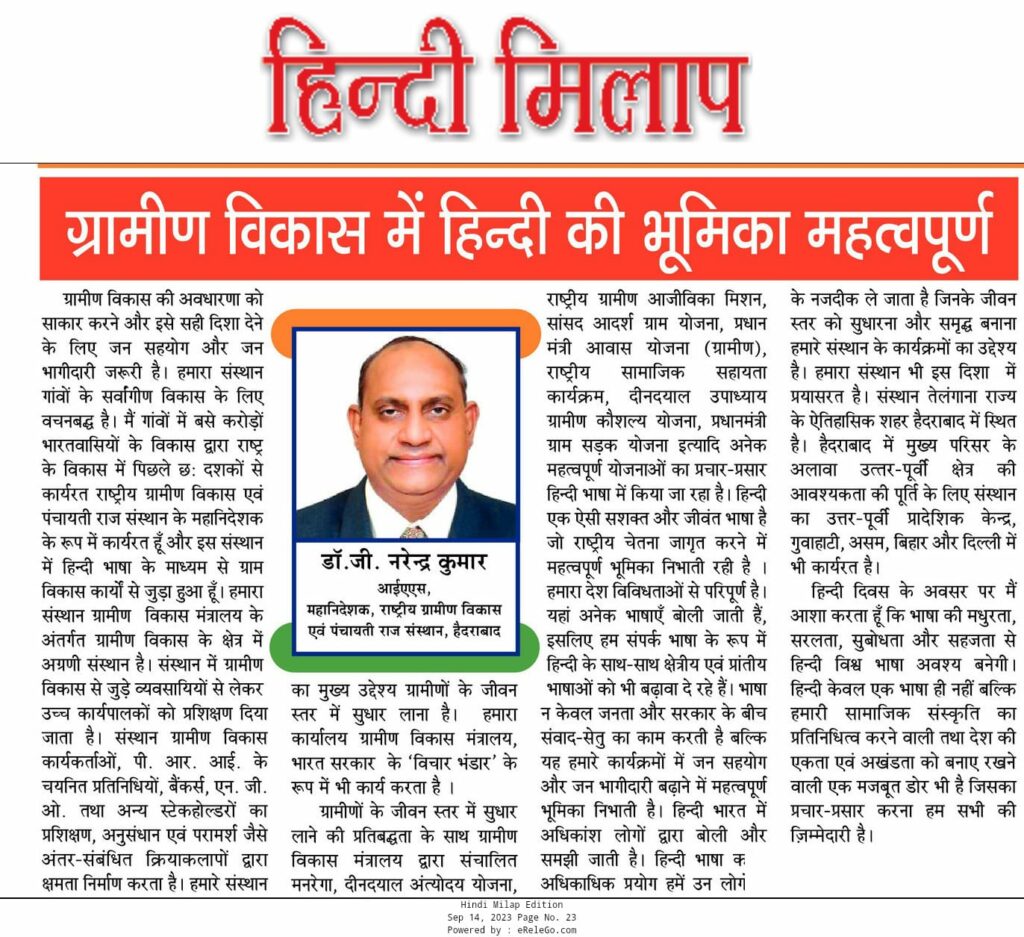
The Director General’s message appeared in Hindi Milap on 14th September 2023 as part of Hindi Diwas
ARTICLE:
Drones as a Catalyst in Enhancing Last Mile Deliveries: A Policy Perspective
Mr. Liankhankhup Guite, IES
Assistant Director, Government of India
khup.guite15@gov.in
&
Ms. Shagun Seth
Student, Gokhale Institute of Politics and Economics, Pune, Maharashtra
India with its diverse and distinct topographical variations and geographical spread has been facing the chronic challenge of last-mile service deliveries, particularly in the healthcare sector. The infrastructural constraints, and unequal distribution of medical facilities coupled with geographical and topographical constraints, especially in the remote and rural regions of the country, continue to hamper the timely and efficient delivery of medical supplies to the intended beneficiaries. It has also been evidenced that the traditional modes of transport such as trucks and vans can seldom reach certain places due to difficult terrain necessitating the frequent need for specialised trucks and drivers. While this approach often manages to address the immediate problems, it comes with huge cost implications and may not be sustainable for the long term. Thus, there has been an increasing focus on leveraging innovative technologies, such as drones or autonomous vehicles, for last-mile healthcare deliveries, especially in the rural parts of India. Globally, efforts have been undertaken wherein firms and organisations have successfully launched projects to incorporate drones into last-mile delivery operations. It has been evidenced that drones have the ability to overcome logistical obstacles, improve accessibility, and increase the efficiency of transporting products and services to remote or difficult-to-reach regions. It is in this context that we seek to present a perspective on how drones can position themselves as a game changer for addressing the challenges of last-mile health service delivery in India.

Background
On August 25, 2021, the Ministry of Civil Aviation (MoCA), Govt. of India issued the liberalised Drone Rules to allow greater utilisation of drones for service deliveries while maintaining safety and security in drone operations. With the implementation of the liberalised rules, the notion of on-demand drone delivery has become the country’s breakthrough invention, capable of realising the long-delayed aim of equitable healthcare access in order to save and improve lives.
Telangana, Nagaland, Manipur, Meghalaya, Uttarakhand and many other States have successfully undertaken drone experiments for a variety of healthcare applications. The documented investigations of a pilot conducted by the Indian Council of Medical Research (ICMR) have supported the argument that employing drones to transport medicine and diagnostic samples in temperature-controlled payload boxes is found to be effective. It is pertinent to mention that during the COVID-19 pandemic, drones have been found to have played an important role in transporting COVID-19 vaccination doses to remote areas in difficult terrain which can be seen from the successful field testing of vaccine distribution in the pilot programme conducted in Manipur. The pilot initiative of Telangana, “Medicine from the sky” shows that drones can also ensure prompt access to critical healthcare supplies by delivering blood products and life-saving anti-venom drugs in an emergency. Recognising the potential of drone technology, these States have made proactive efforts to facilitate drone delivery by constructing distribution centres. These programmes represent a proactive approach to harnessing new solutions for addressing healthcare concerns and increasing population well-being.
Drones: A Catalyst in Improving Access to Healthcare?
With the majority of India’s regions categorised as green zones and areas outside the airport’s five-kilometre radius in yellow zones, the demarcation of the map puts around 95 per cent of commercial drone activities inside the legal space.
For effective implementation of drone technology and improved access to healthcare, the first step would be to establish a comprehensive drone delivery network and the necessary infrastructure. Building a drone delivery network leads to the strengthening of the health infrastructure. In certain circumstances, existing infrastructure, such as a helipad, may be used for drone take-offs and landings. Parking lots, which are often underutilised, can be converted for drone operations as they provide a big, flat surface on which drones may take off and land since they are frequently placed in convenient areas. Drone operations can potentially take place on the roofs of existing health facilities and district hospitals. This can save money and time by eliminating the need to create new infrastructure. Furthermore, if no existing infrastructure is available, a tiny, specialised drone port can be developed. A simple structure, such as a concrete pad with a windsock, can suffice and can be funded by the financial and technical support provided to States under the National Health Mission (NHM) for strengthening their healthcare systems.
There are States/UTs such as Ladakh, Uttarakhand, Kerala, Karnataka, Jharkhand, Himachal Pradesh, Bihar, Assam and Andaman and Nicobar Islands with expenditure less than the amount released by the Central release under National Rural Health Mission (NRHM) in FY 2021-22. Thus, exploring the scope of utilising these funds by creating a separate budget sub-head for drone deliveries can help States in financing drone network development and ensure that drone delivery projects are aligned with State priorities. This would provide a dedicated source of funding, making it easier for States to plan and manage their drone delivery programmes, and encourage private investments for these projects, which is especially crucial considering the reduction in infrastructure provision under the National Health Mission (NHM) budget for 2023-24.

The National Rural Health Mission is aimed at improving public health in India by addressing various aspects, including reducing IMR (Infant Mortality Rate) and MMR (Maternal Mortality Rate), ensuring universal access to healthcare, promoting healthy lifestyles, and integrating traditional medicine (AYUSH) into the mainstream system. Drones can facilitate States in achieving these objectives by transporting medical supplies and equipment to ASHA workers in remote areas, helping them to provide better healthcare to their communities. They can also transport AYUSH (Ayurveda, Yoga, Unani, Siddha, and Homeopathy) products to remote areas, where they can be used to improve the health of the population. For Instance, drones could be used to transport ayurvedic medicines to a village where there is a shortage of doctors.
As a cost-effective approach, States can also consider leasing drones from startups and private companies rather than purchasing them. When a State purchases a drone, it must pay the entire cost upfront. This may be a major cost, particularly for small States. A State, on the other hand, may spread the expense of a drone across time by leasing it which can make acquiring drones more economical for States. Overall, India can improve the responsiveness and efficiency of public health systems by incorporating two-way drone transport and adapting it to the particular demands of each State, ultimately leading to greater disease management and population well-being.
Since the government is the largest buyer, it may act as a market maker. The budget 2022 announcement also gave a major policy for streamlining drones as a service. The government’s ‘Drone Shakti’ scheme focuses on promoting startups and encouraging the widespread use of drones across sectors proving the government’s clear vision and focus towards this emerging industry. We must now concentrate on the pilot-to-scale journey. The objective is to raise payloads from 2-5 kilos to 25/50/100 kilos which can be used in organ transfers, expand the range of items to be delivered, and produce higher quality drones with a life of at least 6500-8000 landings to make drone deliveries more efficient and cost-effective. Daily pre-planned flights and extra drones for disaster readiness can help cut these expenses even more.
As drone technology continues to evolve, we can expect even more innovative applications in healthcare, from telemedicine consultations to emergency response services. Drone technology’s successful implementation in the health sector holds great promise for revolutionising healthcare systems and improving patient outcomes on a larger scale.
(Views expressed by the authors are personal.)
Training Programme on Poverty and Inequality Estimation for ISS Probationers
The Centre for Entrepreneurship Development & Financial Inclusion, NIRDPR conducted a 5-day residential training programme on ‘Poverty and Inequality Estimation’ for Indian Statistical Service (ISS) Probationers (44th – 2022 batch), from 18-22 September 2023, on the Institute’s Hyderabad campus. The programme was sponsored by National Statistical System Training Academy (NSSTA), MoSPI, Govt. of India
The training programme was designed to offer a fine blend of theory, practice, experiential learning and lessons from good practices that will empower the participants to understand and assess the diverse range of emerging issues and concerns relating to poverty and inequality. It was also envisaged to enhance skills and expertise to critically analyse government schemes and programmes designed to address poverty and inequality. A series of lectures was arranged on various dimensions of poverty and inequality, especially from the perspective of rural development. In all sessions, discussions were carried out on inter-disciplinary, evidence-based and research-driven.
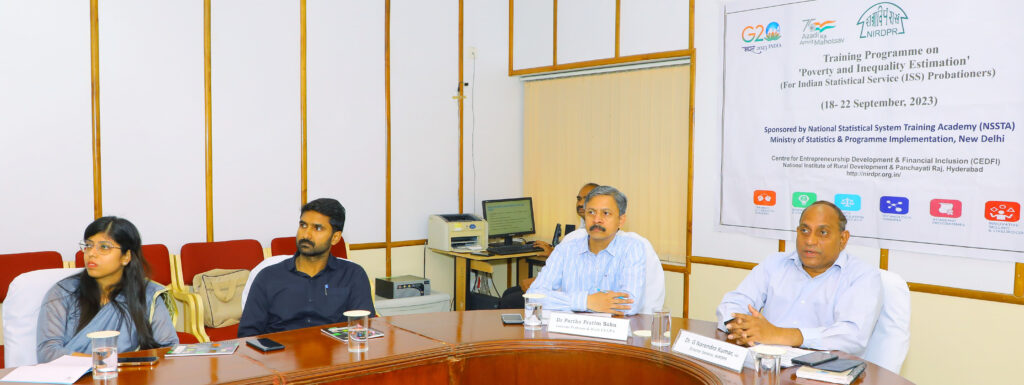
Ten ISS probationers, who were recently posted in various government departments such as regional offices of NSSO and ministries such as Jal Shakti, Defence, Tourism, Fisheries, Animal Husbandry & Dairying and New & Renewable Energy, participated in this training programme. Dr G. Narendra Kumar, IAS, DG, NIRDPR delivered the inaugural address and interacted with the officers. In his address, he discussed India’s development journey, the achievements and initiatives undertaken in the rural development landscape, and significant development legislations and institutions in rural development. He spoke about a series of development legislations like MGNREGA, RTE, RTI, NFSA and so on. The DG also emphasised the crucial role played by development institutions such as PRIs, SHGs, cooperatives, MFIs, FPOs and so on. Many emerging rural development initiatives such as the Localisation of SDGs, Panchayat Citizens Charters, development of SHG-based micro-enterprises, and Aspirational Block Development Programmes were also been discussed by him, where NIRDPR is playing a vital role in arranging training and capacity development programmes for successful implementation of these initiatives. He motivated participants to learn and practice thought leadership and work for the poor, vulnerable and marginalised sections of the society.
Dr Himanshu from JNU took a comprehensive session on concepts, measurement issues and various committees on poverty and inequality. He also discussed the global scenarios of poverty and inequality. He very lucidly clarified various advantages and disadvantages of various measures of poverty and inequality, which the statistical officers must be aware of. He also discussed the use of MDPI and various concerns relating to it. Dr M. Satish Kumar, Queen University Belfast delivered a special lecture on ‘Impact of Covid: Why Regional Convergence Matters in the Global South’, using a large-scale data set i.e. Johns Hopkins University CSSE COVID-19 Data. He highlighted the necessity of good quality data at the right time for robust policymaking.
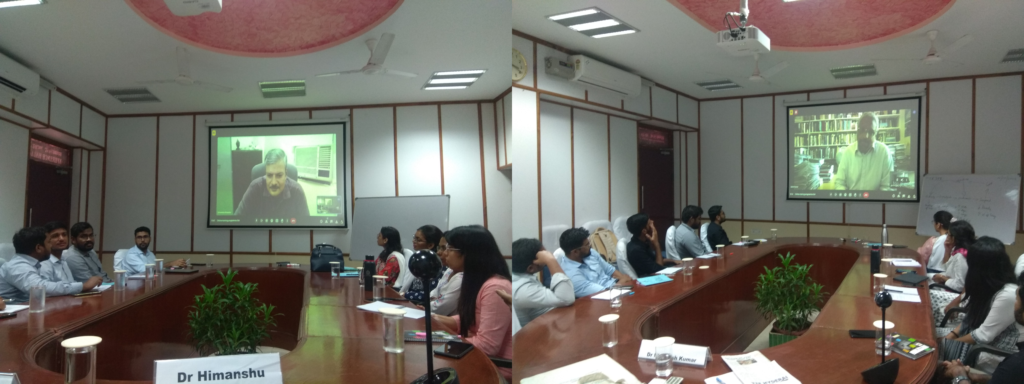
Theme-based lectures, including contextualising poverty and inequality in rural development, longitudinal village studies, large-scale public employment programmes – MGNREGA, role of SHG-based interventions, panchayat level statistics, role of GPDP, skilling programme, climate change and biodiversity, etc., were arranged. In all these sessions, attempts were made to connect the discussion with poverty and inequality and their various dimensions. The participants were also appraised about a large number of datasets which one can use to understand various facets of poverty and inequality.
The participants were taken to RTP to see live demonstrations of more than 20 livelihood models as well as affordable housing typologies. A visit was arranged to the Council of Social Development, Hyderabad to appraise participants about the schemes and programmes of Telangana Government for addressing poverty and inequality. All participants appreciated these field/exposure visits.
Despite having a large number of schemes and programmes relating to various dimensions of poverty and inequality, the desired outcomes are hindered by poor implementation, lack of transparency and monitoring systems. To appraise participants about an emerging tool, i.e. social audit, a session was spent on Improving Transparency and Accountability of Anti-poverty Programmes: Learnings from Social Audit System.
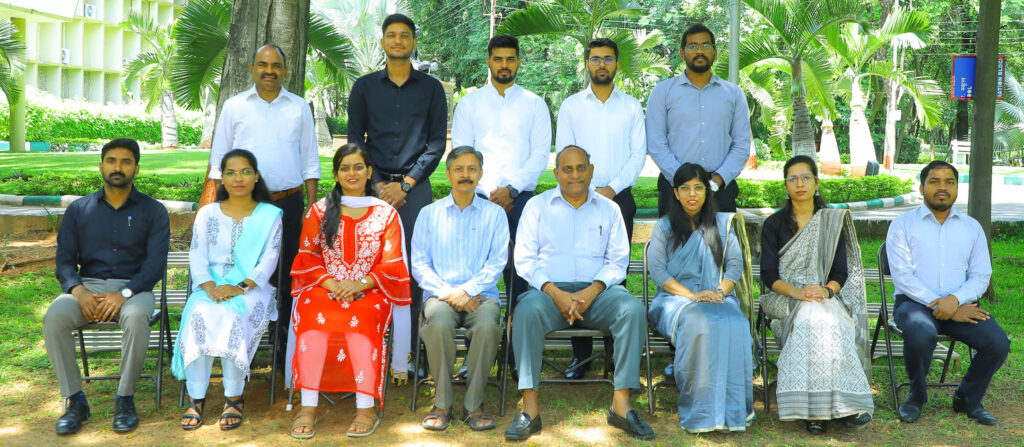
In addition to these sessions, pre- and post-training quizzes were undertaken. Detailed feedback was taken in the last session as well via the Training Management Portal (TMP). All the probationers found the programme useful and they promised to apply the learnings from it in their professional work. Overall, the intent and spirit on which this programme was conducted, seems to have delivered the desired outcomes.
This programme was conducted by Dr Partha Pratim Sahu, Associate Professor and Head, CEDFI, NIRDPR.
Regional Workshop on Capacity Building of School Management Committees in Rural Areas
Keeping in view the importance and crucial role of School Management Committees for bringing in the quality of education, particularly in rural schools as envisaged in the New Educational Policy 2020, the National Institute of Rural Development and Panchayati Raj conducted a 3-day Regional Workshop on Capacity Building of School Management Committees in Rural Areas from 13th-15th September, 2023. The programme conducted on the Institute campus in Hyderabadwas the fourth in the series.
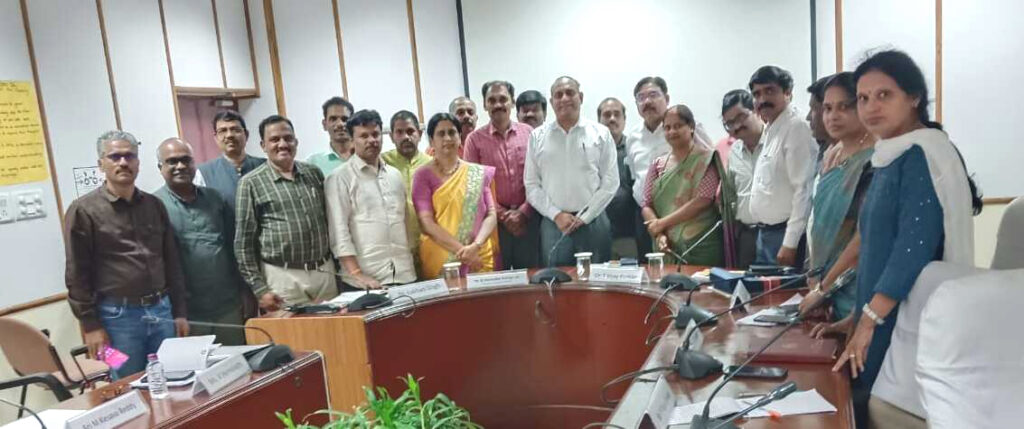
The workshop intended to deliberate upon the different aspects of School Management Committees/School Development Management Committees of public schools of rural areas such as SMC constitution, process and functioning, impact of SMCs functioning, capacity building of SMCs, challenges faced by SMCs, good practices to strengthen SMCs, etc. The main objectives of this workshop were as follows:
- To discuss the current issues of School Management Committees of rural public schools
- To demonstrate the successful models of School Management Committees and possibilities of replicating them in the country
- To suggest strategies to empower School Management Committees of public schools in rural areas
- To design a capacity building training programme on issues and challenges of School Management Committees of rural schools
As many as 20 officials such as DEOs, CMOs of Samgra Shikhsa, Senior Lecturers, Head Masters, APCs, Nodal Officers and other State and district level officers from Education Departments of Andhra Pradesh, Telangana, Karnataka, Maharashtra, and Kerala attended this workshop.
Eminent scholars and subject matter specialists from MV Foundation, Member Secretary-NCERT-Bhopal, Professor from Nagaland University, CEO of SADHANA, SMC Chairman, etc., deliberated upon the important aspects such as Challenges/Issues of Effective Functioning of School Management committees, Commoditization of Education: Empowering of SMCs: Experience from Nagaland, Capacity Building of SMCs to Promote Rural School Governance and Leadership, Approaches and Strategies of Empowering of SMCs, etc.
The participants made suitable recommendations/suggestions for improvement of School Management Committees of rural schools which will be further used as training inputs for subsequent programmes on education.
Dr G. Narendra Kumar, IAS, Director General of NIRDPR, Hyderabad, during his valedictory address, spoke on the role of SMCs in improving the quality of education in rural schools. He emphasised the need for healthy linkage between SMCs and Panchayat Raj Institutions to ensure quality education. Dr G. Narendra Kumar further shared his rich experience as the Secretary of Education in Pondicherry, besides suggesting the need for formulation of good operating guidelines for the effective functioning of SMCs.
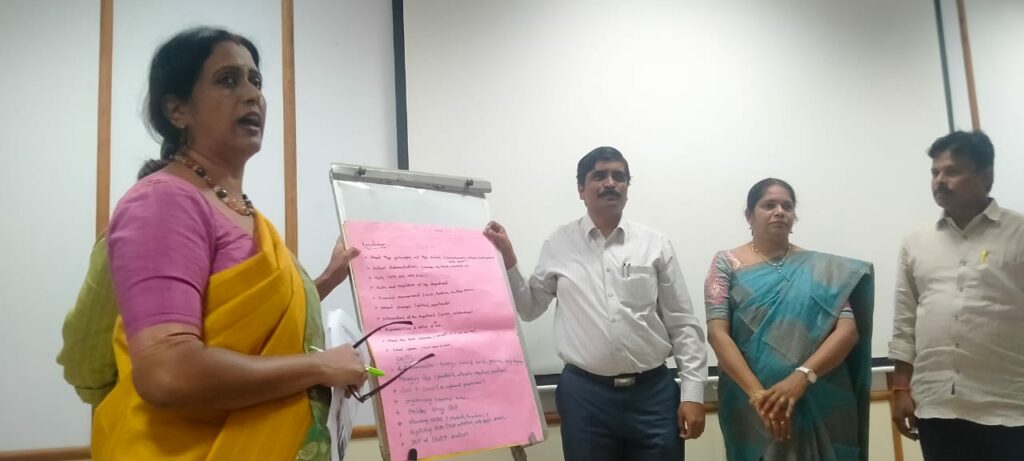
The participants expressed their utmost satisfaction with their participation and ensured that the suggestions/recommendations that emerged in this workshop would be practised in their respective places with a view to improving the capacities of SMCs and creating a congenial environment in the schools.
The workshop was conducted by Dr Lakhan Singh, Assistant Professor, CHRD and Dr T Vijaya Kumar, Associate Professor, NERC-NIRDPR, Guwahati.
The workshop ended with a vote of thanks by the Course Team.
Training Programme on Development of Managerial Skills for Fishery Officers from Odisha
A six-day training programme on ‘Development of Managerial Skill, Leadership Development, Extension and Accounting for the Fishery Officers, Govt. of Odisha’ was organised by the Centre for Natural Resource Management, Climate Change and Disaster Mitigation, NIRDPR from 18th to 23rd September 2023. A total of 35 Assistant Fishery officers of the Fishery Department, Odisha State attended the programme.
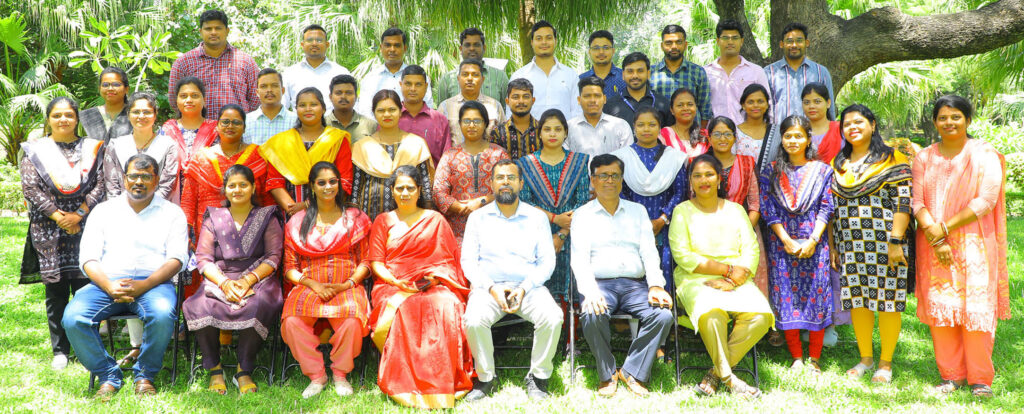
The objectives of the programme were to enhance managerial skills, improve extension techniques and strengthen the accounting and financial management skills of the officers.
The Programme began with a welcome address by Dr Ravindra S. Gavali, Professor & Head, CNRM, CC & DM, NIRDPR, Hyderabad. Dr Gavali further delivered the inaugural address, emphasizing the significance of managerial skills, leadership development, and accounting in the context of Fishery Officers.
Dr C. Suvarna, IFS, PCCF (Harithaharam) delivered a comprehensive lecture on the concept of sustainable fisheries and the pivotal role of Fishery Officers. She emphasised the urgent need to prioritise sustainable practices in fisheries management to ensure the long-term health of aquatic ecosystems and the livelihoods of communities dependent on them.
Dr Subrat Kumar Mishra, Associate Professor, CNRM, CC&DM, delivered a lecture on the convergence of rural development initiatives with the Prime Minister Matsya Sampada Yojana (PMMSY). Through practical examples, he taught how integration could enhance local economies and resource management.

Dr Partha Pratim Sahu, Associated Professor, NIRDPR shared valuable insights on promoting entrepreneurship within the fishery sector. He explained how individuals can start businesses related to fisheries, like fish farming or processing, and the importance of innovation in this field.
Dr A. K. Saxena (Professor, SVPNP) offered a lecture on leadership and motivation skills. He used real-life examples and interactive exercises to demonstrate effective leadership techniques and how motivation can drive success.
Dr V. K. Reddy’s lecture on the principles and practices of teamwork explained the core principles of effective teamwork, emphasizing the importance of communication, trust, and mutual respect among team members at workplace.

In his lecture on climate change adaptation in the fishery sector Dr Ravindra Gavali provided valuable insights into strategies and practices to mitigate these effects, including sustainable resource management and technology adoption. He actively engaged participants by conducting a survey on climate change adaptation within the fishery sector.
Dr Akanksha Shukla’s (Associate Professor, NIRDPR) lecture on information dissemination and communication skills stressed the importance of local and social media in promoting sustainable fish farming. Mrs. Nagalaxmi delivered a concise yet comprehensive lecture on the basics of financial accounting, covering essential topics such as the Balance Sheet, Profit and loss Account, Fund Flow, and Cash Flow.
Dr Swarnalatha Jagarlapudi, Professor, ASCI, delivered an insightful lecture on effectively managing stress at workplace. Her presentation provided practical strategies for identifying, addressing, and mitigating stressors in the professional environment. Dr Sonal Mobar Roy Assistant Professor, NIRDPR took an insightful lecture on Participatory Rural Appraisal (PRA) which was highly informative. She elucidated the significance of PRA in involving local communities in decision-making and development processes.
The participants visited Kravis Aqua in Balanagar where its MD Mr Vishwanatha Raju delivered a lecture on Re-circulating Aquaculture Systems (RAS) and Integrated Farming Techniques, shedding light on sustainable aquaculture practices. Further, they witnessed firsthand the cutting-edge technologies in action at Kravis Aqua’s RAS unit.
Dr A.K. Saxena’s lecture on problem-solving and conflict resolution provided practical strategies and techniques for effectively addressing workplace challenges and resolving conflicts.
Dr Ganesh Kumar’s lecture on Farmer and Market Linkage in the fishery sector emphasized the importance of connecting farmers with markets to promote economic sustainability. Dr Ganesh highlighted various strategies and best practices for bridging this crucial gap, empowering participants with insights on how to facilitate efficient market access for fishery products.
Participants collaborated in group work to prepare a perspective plan to enhance fish farming practices and presented their plans that showcased diverse strategies.
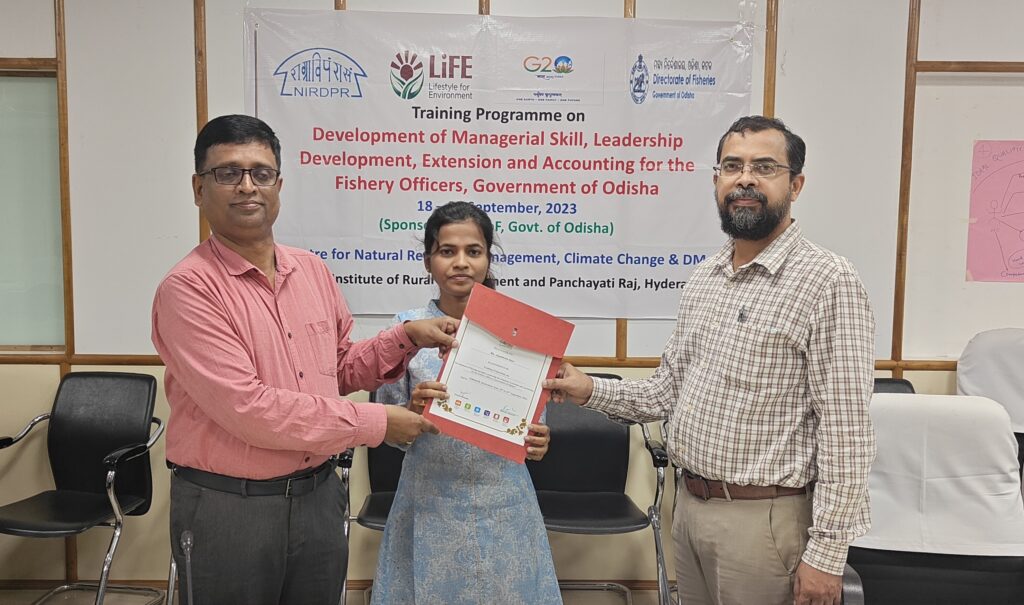
Dr Ravindra S Gavali, Professor & Head, CNRM, CC&DM delivered a valedictory address, reflecting on the programme’s significance. Further, Dr Gavali and Dr Subrat Kumar Mishra distributed certificates to the participants.
The training programme’s effectiveness was evaluated through TMP and a post-training test. The overall effectiveness of the programme was found to be 85 per cent. The feedback suggested incorporating more field visits in the upcoming training programmes.
TOLIC-2 Meeting at Council for Social Development under the Aegis of NIRDPR
A meeting of the Town Official Language Implementation Committee (TOLIC-2), Hyderabad, was organised by the Council for Social Development (CSD) under the aegis of the National Institute of Rural Development and Panchayati Raj (NIRDPR), Hyderabad, on 22nd September 2023.
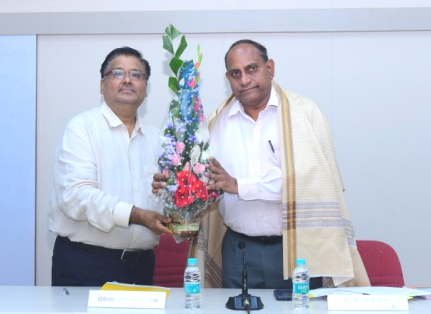
The meeting held under the chairmanship of Dr G. Narendra Kumar, IAS, Director General, NIRDPR and Chairman, Town Official Language Implementation Committee, started with the national anthem and lighting of the lamp. On this occasion, Dr. KBRS Visarada, Director of the Indian Institute of Millets Research, Rajendrnagar was present as a special guest. Professor Sujit Kumar Mishra, Regional Director of Council for Social Development, and Mrs Bela, Deputy Director, Hindi Teaching Scheme, Kavadiguda, Secunderabad were also present.
Dr. Mohd. Wasim Akhtar, Junior Research Officer, Council for Social Development welcomed the Chairman and guests. Smt. Anita Pandey, Member Secretary of TOLIC-2 & Assistant Director (OL), NIRDPR presented the report and resolved the doubts of the members.
Dr G Narendra Kumar, TOLC-2 Chairman and Director General, NIRDPR, delivered the presidential address. “We are suffering from the mental slavery of English. We have to get out of this mentality; only then we will be able to take Hindi forward,” he said and instructed all offices to do most of their work in Hindi.

Professor Sujit Kumar Mishra elaborated on the activities of the Council for Social Development. Dr KBRS Visarada made a comprehensive presentation about millets and its uses.
As a representative of the Department of Official Language, Mrs Bela, Deputy Director of the Hindi Teaching Scheme, spoke about intensive course training including Prabodh, Praveen, Pragya and Parangat. Dr. Mohd. Wasim Akhtar presented the vote of thanks.
Shri E. Ramesh, Senior Hindi Translator, NIRDPR compered the meeting. The staff of Official Language section of the NIRDPR and the employees of the CSD coordinated the programme.
ARTICLE:
Understanding the Association for Computing Machinery (ACM): A Pillar of the Computer Science Community
Sunil K. Jha, Data Processing Assistant
Centre for Information and Communication Technology
NIRDPR, Hyderabad
jhasunil.nird@gov.in
The pivotal role of ICT in Rural Development encompasses enhancing efficiency, fostering openness, and promoting responsiveness, as well as facilitating participation in the creation and execution of rural development initiatives. This article aims to raise awareness among individuals involved in rural development about the Association for Computing Machinery (ACM), an organisation that bestows the Turing Award, frequently hailed as the “Nobel Prize in Computing,” the most esteemed accolade in the realm of computer science.
Introduction
The Association for Computing Machinery (ACM) is a globally renowned professional organisation that plays a pivotal role in advancing the field of computer science and information technology. Founded in 1947, ACM has grown to become one of the most influential and prestigious organisations in the world of computing. In this article, we will delve into the history, mission, activities, and significance of ACM in the ever-evolving realm of computer science.
A Brief History of ACM
ACM was established shortly after World War II when the field of computing was still in its infancy. A group of visionary computer scientists, including Dr. Albert G. Hill, realised the need for a platform that could promote collaboration, share knowledge, and advocate for the growth of computing as an academic and professional discipline. This led to the birth of ACM on 15th September 1947, at a meeting held at Columbia University in New York City.
Over the decades, ACM has played an instrumental role in shaping the field of computing through its publications, conferences, educational initiatives, and advocacy efforts. Today, ACM boasts a diverse and extensive global membership, comprising professionals, researchers, educators, and students.
Mission and Objectives
The mission of ACM is encapsulated in its mission statement: “Advancing Computing as a Science & Profession.” To fulfil this mission, ACM has set several key objectives:
1. Promoting Research and Innovation: ACM provides a platform for researchers and professionals to share their discoveries and innovations through its numerous conferences, journals, and magazines. These publications serve as valuable resources for staying up-to-date with the latest advancements in computing.
2. Education and Outreach: ACM is committed to promoting computer science education at all levels. Through initiatives like the ACM Education Board, ACM aims to develop curricula, provide resources for educators, and support the next generation of computer scientists.
3. Professional Development: ACM offers numerous resources and opportunities for professional growth. This includes access to a vast digital library, special interest groups (SIGs) focusing on specific computing domains, and career development resources.
4. Advocacy and Public Policy: ACM actively engages in advocating for policies and regulations that support the computing community. It provides a voice for the profession in government and policy discussions, ensuring that the interests of computer scientists are considered.
Activities and Initiatives
ACM’s impact on the field of computer science is far-reaching. Some of its most notable activities and initiatives include:
1. ACM Digital Library: This vast repository of computing literature includes journals, magazines, conference proceedings, and technical magazines, providing members with access to an extensive body of knowledge.
2. ACM Special Interest Groups (SIGs): ACM’s SIGs focus on specific areas of computing, such as SIGGRAPH for computer graphics or SIGPLAN for programming languages. These SIGs organise conferences, publications, and events tailored to their respective domains.
3. ACM Conferences: ACM sponsors and co-sponsors conferences around the world, serving as essential platforms for networking, knowledge sharing, and collaboration within the computing community.
4. ACM Awards: ACM recognises outstanding contributions to the field through prestigious awards like the Turing Award, the ACM Prize in Computing, and various SIG-specific awards.
Significance in the Computing Community
The ACM has played a vital role in advancing computing as both a science and a profession. Its significance in the computing community can be summarised as follows:
1. Knowledge Dissemination: ACM’s publications and conferences facilitate the dissemination of cutting-edge research, ensuring that professionals and researchers have access to the latest developments in the field.
2. Professional Networking: ACM provides a global network for professionals to connect, collaborate, and share ideas, fostering a sense of community within the computing world.
3. Education and Skill Development: ACM’s educational resources and initiatives contribute to the growth of the computing workforce by nurturing talent and fostering the development of relevant skills.
4. Advocacy: ACM’s advocacy efforts help shape policies and regulations related to computing, ensuring that the profession’s interests are represented and protected.
Conclusion
The Association for Computing Machinery (ACM) stands as a cornerstone of the computer science community, guiding the field’s growth and development for over seven decades. Its commitment to research, education, and advocacy has made it an indispensable resource for professionals, researchers, educators, and students in the world of computing. As the field of computing continues to evolve, ACM’s role in shaping its future remains paramount, ensuring that it continues to thrive as both a science and a profession.
ToT on GIS-based Planning and Monitoring of MGNREGA at IGPR&GVS, Rajasthan
The Centre for Rural Infrastructure (CRI), NIRDPR organised three Training of Trainers programmes on ‘GIS-based Planning and Monitoring of Mahatma Gandhi NREGA at GP level using Yuktdhara’ during 21st-23rd August, 24th-26th August, and 04th-06th September, 2023 at IGPR&GVS (SIRD, Rajasthan).
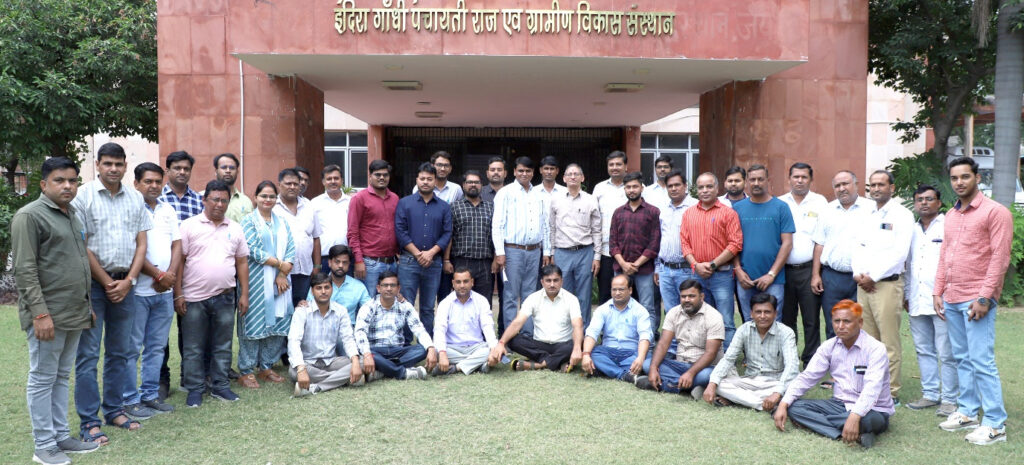
The three-day programmes were mainly envisaged for engineers and officials working as BTRTs in NREGA. A total of 38 participants attended the first two programmes whereas 37 participants attended the third one from various Blocks of Rajasthan.
The first day of the programme comprised Introduction to Geo-informatics and its Applications in Planning & Monitoring of MGNREGA, Ridge to Valley Concept and Watershed in Context of MGNREGA, Introduction to Yuktdhara –A Geo-Spatial Application for Planning and Monitoring of MGNREGA, and Demonstration of Yuktdhara.
On the second day, topics such as INRM planning under MGNREGS: Geospatial approach, Hands-on Yuktdhara for Landscape Familiarisation & Identify Drainage Line Treatment, Hands-on Yuktdhara for Identify Area Treatment & Map composition were covered. State-level officials of MGNREGA handled sessions on NGREGASoft MIS: Clarifications and discussions, State monitoring strategy through Secure app, etc.
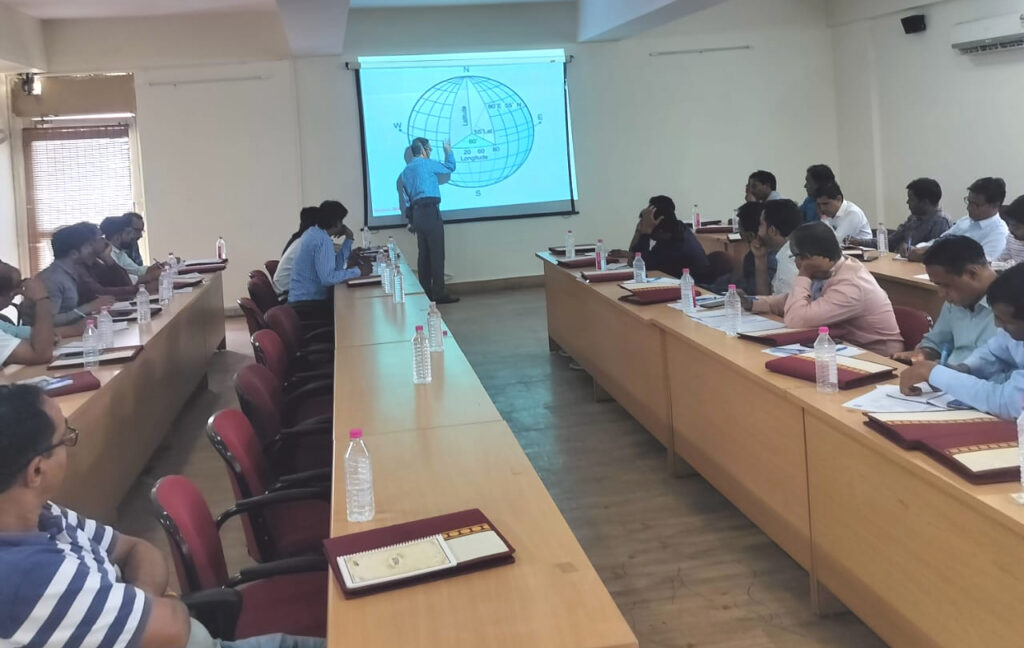
The final day’s schedule included Introduction to the Preparation of GP Plans under MGNREGA using Yuktdhara followed by Hands-on Preparation of GP Plans under MGNREGA using Yuktdhara, Review of GP plans prepared, and clarifications.
The feedback was taken on TMP and the overall effectiveness of the three programmes was 90 per cent, 93 per cent and 95 per cent, respectively.
Shri H. K. Solanki, Sr. Assistant Professor, CRI, NIRDPR coordinated the course with the support of Shri Ramavatar Meena, Associate Professor & Joint Director, IGPR&GVS and Ms R. L. Sudha, Training Associate, CRI under the overall supervision and guidance of Dr P. Kesava Rao, Associate Professor & Head, CGARD, NIRDPR.
ToT on Capacity Building Programme on e-GramSwaraj Portal for PRI Functionaries at GIPARD
The Centre for Good Governance and Policy Analysis (CGGPA) organised an off-campus ToT on ‘Capacity Building programme on e-GramSwaraj Portal for PRI Functionaries’ at Goa Institute of Public Administration and Rural Development (GIPARD), from 16th-19th August 2023.
A total of 40 PRI functionaries participated in this programme sponsored by the Ministry of Panchayati Raj, Govt. of India. The programme aimed to build the skills and knowledge of the functionaries on the latest developments of e-GramSwaraj Portal by elaborately focusing on the technical issues and challenges in all modules of the portal.
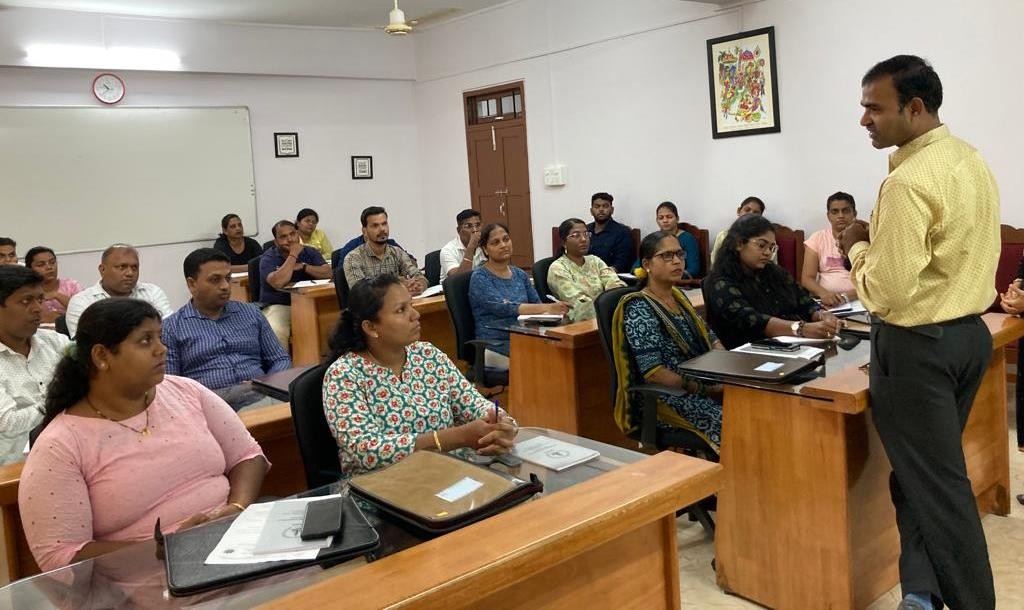
Shri K. Rajeshwar, Assistant Professor, Centre for Good Governance and Policy Analysis (CGGPA), NIRDPR & Programme Director, welcomed the participants and briefed the objectives of the training programme. Dr Seema Fernandes, Assistant Director, GIPARD inaugurated the programme and highlighted the importance of uploading Gram Panchayat Development Plan on GPDP and eGramSwaraj portals. She also mentioned the latest developments in planning with a special focus on rolling out the SDGs and themes to be included in the GPDP.
The ToT covered sessions on Panchayat profile, planning module integration with Sanklap Siddi in vibrant Gram Sabha, progress and financial reporting by highlighting the significance of PFMS on 15th FC grants and Gram Manchitra with a focus on planning.
The training methods of the course were delivered through participatory learning process. The sessions were dynamic and included introductory presentations, interactive sessions, lectures, documentary presentations, brainstorming and practical exercises and hands-on sessions.
The training programme was coordinated by Shri K. Rajeshwar, Assistant Professor, CGGPA, NIRDPR and Ms Ashwini Acharya, Core Faculty from GIPARD. The participants expressed satisfaction with the programme design & delivery, contents, as well as hospitality arrangements. Their feedback was taken in TMP and the programme received an overall rating of 90 per cent.
